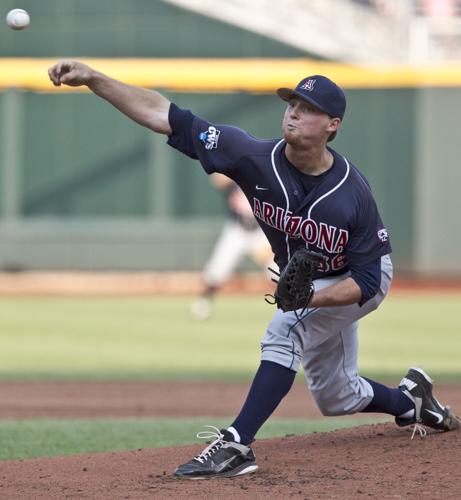They’ve pitched in independent leagues, Mexico, Canada, Australia, Italy. From Modesto to Mazatlán, Trois-Rivières to Tacoma, Sioux City to Sioux Falls.
They’re still pitching. They’re still probing. They’re still pursuing what they once had and could recapture at any moment.
Kurt Heyer and Konner Wade achieved the ultimate glory in college baseball. They formed an indomitable duo for the 2012 Arizona Wildcats, leading them to the College World Series championship.
They combined for a 24-5 record that year with 13 complete games. Heyer had a 2.24 ERA; Wade limited opponents to a .237 batting average.
Heyer owned the opposition in Omaha; Wade took his game to an even higher plane on the sport’s biggest stage. Arizona had a talented, well-rounded team. But it all started with them.
They eventually moved on to professional baseball, and what a journey it’s been. Heyer’s Baseball Reference page could fill a passport booklet. He’s currently pitching for Pericos de Puebla in the Mexican League. Wade is toiling for the Tacoma Rainiers, the Triple-A affiliate of the Seattle Mariners.
Wade made it to the majors, briefly, with the Baltimore Orioles in 2021. Heyer, once the best pitcher on the best team in college baseball, never has.
Ten years since that unforgettable run to the CWS title, Arizona’s aces are in their 30s with grownup responsibilities. Wade and wife Lara have an 18-month-old daughter, Ella. Heyer is engaged and getting married in October.
They will continue to play the game they love until somebody tells them they can’t.
“It’s the purest competition,” Heyer said. “You’ve got a ball, the other guy’s got a stick and you’re trying to better each other. It’s 1-on-1. It’s, ‘Here you go, try to hit it.’
“It’s thrilling. I tell people all the time: The day that I don’t get butterflies or jitters is the day I retire. And I haven’t had that feeling yet.”
Said Wade: “If there was another profession that I got the same kind of thrill out of when I’m facing a hitter, I would go do it. But I haven’t found it yet.
“Thankfully, someone’s still allowing me to play this game professionally. Until that’s over and I can’t put food on the table doing this, I’m gonna keep doing it.”

Kurt Heyer was a master of command during his time as the Arizona Wildcats' ace.
Always in command
Heyer was That Guy for the 2012 Wildcats — as effective as any Friday-night starter in the country. But he didn’t have exceptional velocity or a wipeout breaking pitch. He relied on uncommon command of his fastball.
“The best strike-thrower in the game,” former UA coach Andy Lopez said. “I coached for 38 years. I was a pitching coach. I had Josh Fogg. I had Mark Melancon. Guys that pitched in the big leagues.
“Kurt Heyer could throw it into a thimble on the outer half if you asked him to. His command was spectacular. It wasn’t good. It was spectacular.”
The numbers Heyer posted as a junior in 2012 don’t make sense in today’s game, in which strikeouts are so prevalent. The right-hander fanned only 113 batters in 153 innings. He allowed 151 hits. But he issued only 28 walks, yielding a sparkling 1.17 WHIP.
It was all about locating that upper-80s fastball.
“Obviously, I’d throw in a wrinkle with my slider once in a while,” Heyer said. “But 70% of the time I’m throwing fastballs, and it was just a formula that was working when I was there.”
The St. Louis Cardinals selected Heyer in the sixth round of the 2012 MLB draft. As he tried to work his way up through pro ball, Heyer discovered that he needed additional pitches.
“You can’t make it through life with just a fastball and slider,” Heyer said. “I had to develop a cutter and another off-speed pitch.
“You have to add to the toolbox. I used what I learned in college. Then I needed to develop a changeup. That’s what made Konner so good. He had a changeup right off the bat.”
Wade had a bigger repertoire than Heyer. His pitches had more movement. Controlling them proved to be a monumental challenge early in 2012.

Arizona pitcher Konner Wade struggled with his control early in the Wildcats’ 2012 national championship season.
‘Definitely a struggle’
The estimates vary, from 3 feet to 10. Whatever the true distance, Wade was missing the plate. Badly.
When the Wildcats reconvened in January 2012, Wade came down with a case of the yips. It’s something every baseball player dreads. For a pitcher, there’s no place to hide.
“I remember the look in that young man’s eyes,” Lopez said. “Like, ‘What is going on, Coach?’”
“That was definitely a struggle,” Wade said. “It’s something that I hadn’t really dealt with before. Just came back and didn’t really know where the ball was going.
“My ball was moving a ton, more than it normally did. It took me the better part of a season to really get that under control.”
A combination of hard work, persistence, patience and prayer enabled Wade to rediscover his form. But it was no easy task.
In a March 21 relief appearance against New Mexico State, Wade allowed four runs in one inning — without surrendering a hit. He walked four batters, hit two and threw a wild pitch.
In that context, what Wade was able to accomplish in the postseason was truly incredible.
The right-hander made four starts. He won them all. Three were complete games. Wade allowed only five earned runs.
Here’s the real kicker, though: Wade walked only three batters in 35 innings — one fewer than in that relief outing against NMSU.
Wade shut out UCLA in Omaha without allowing a walk. In the opener of the CWS Finals, Wade issued one walk and allowed one run against two-time defending national champion South Carolina.
“He was spectacular against UCLA, and he was deeper in the alphabet against South Carolina,” Lopez said. “He was unreal.”
In less than six months, Wade went from a pitcher who couldn’t find the plate to one who couldn’t miss it.
“I’d have flashes of really good games, and then the next game I’d be pretty bad,” said Wade, who’d pitch one more season at Arizona before the Colorado Rockies took him in the seventh round of the 2013 draft. “Then I’d have a couple of good ones and bad ones.
“It was just a culmination of reining things back in. In the end, it kind of clicked.”

After not pitching for three weeks, James Farris was named the starter for Game 2 of the College World Series finals — and delivered a national championship for the Cats.
Farris’ day on
The great irony of Arizona’s 2012 championship is that neither Heyer nor Wade started the clinching game.
Wade pitched the opener of the best-of-three series against South Carolina. Lopez could have used Heyer in Game 2 on three days’ rest. Or Lopez could hand the ball to sophomore James Farris — who hadn’t pitched in more than three weeks — and save Heyer for a possible Game 3.
Lopez had discussed the issue with his coaching staff and told both pitchers he’d sleep on it when he stepped into the elevator at the team hotel after Game 1. Alex Mejia, Robert Refsnyder and Joey Rickard — three of Arizona’s best players — happened to be in the elevator as well.
Mejia asked Lopez, “Who are with going with tomorrow?”
“I don’t know,” Lopez replied. “Who should I throw?”
All three players offered the same answer: Farris.
“I would trust those guys with the keys to my house,” Lopez said. “So I got off the elevator, went right to Farris’ room and said, ‘I just made the decision. You’re going tomorrow.’
“Then I went to Heyer: ‘You’ll go the next day if we need you.’ He goes, ‘OK, I got it, Lopes.’ That’s how it went.
“And man, Farris was good.”
Farris limited the Gamecocks to one run on two hits in 7 2/3 innings. The Wildcats scored three runs in the top of the ninth and won 4-1.
“The fact that he was able to go in there and just absolutely be nails was huge for us and a testament to the kind of patience and focus he had,” Heyer said. “Especially in a game like that.”
Heyer wanted to close the game. He wanted to secure the final out.
He also knew he might be needed the next day. It was no time to be selfish.
So Heyer watched, along with Wade, as freshman closer Mathew Troupe finished off South Carolina. They’d done more than enough.
Photos: Wildcats win 2012 College World Series
Arizona Wildcats win College World Series
Updated
Arizona players, including Johnny Field, top, pile up following their 4-1 victory over South Carolina to win the NCAA College World Series baseball finals in Omaha, Neb., Monday, June 25, 2012. (AP Photo/Ted Kirk)
Arizona Wildcats win College World Series
Updated
Arizona Wildcats' Joey Rickard, left, congratulates Joseph Maggi, who scored in the third inning against the South Carolina Gamecocks during the College World Series at TD Ameritrade Park in Omaha, Nebraska, Monday, June 25, 2012. (Gerry Melendez/The State/MCT)
Arizona Wildcats win College World Series
Updated
Arizona starting pitcher James Farris delivers against South Carolina in the first inning of Game 2 of the NCAA College World Series best-of-three baseball finals, in Omaha, Neb., Monday, June 25, 2012. (AP Photo/Nati Harnik)
Arizona Wildcats win College World Series
Updated
Arizona second baseman Trent Gilbert (4) leaps over South Carolina's Chase Vergason, who stole second base and went on to third on a throwing error, in the eighth inning of Game 2 of the NCAA College World Series baseball finals in Omaha, Neb., Monday, June 25, 2012. (AP Photo/Ted Kirk)
Arizona Wildcats win College World Series
Updated
Joseph Maggi of the Arizona Wildcats is safe at second in the third inning of the College World Series against the South Carolina Gamecocks at TD Ameritrade Park in Omaha, Nebraska, Monday, June 25, 2012. (Gerry Melendez/The State/MCT)
Arizona Wildcats win College World Series
Updated
Arizona left fielder Johnny Field tracks and catches a fly ball hit by South Carolina's Grayson Greiner in the third inning of Game 2 of the NCAA College World Series baseball finals in Omaha, Neb., Monday, June 25, 2012. (AP Photo/Eric Francis)
Arizona Wildcats win College World Series
Updated
Arizona's Robert Refsnyder (2) celebrates with Konner Wade (48) after scoring the go-ahead run against South Carolina on a double by Brandon Dixon in the ninth inning of Game 2 of the NCAA College World Series baseball finals in Omaha, Neb., Monday, June 25, 2012. (AP Photo/Ted Kirk)
Arizona Wildcats win College World Series
Updated
South Carolina's Nolan Belcher performs his traditional back flip before Game 2 of the NCAA College World Series baseball finals against Arizona, in Omaha, Neb., Monday, June 25, 2012. (AP Photo/Eric Francis)
Arizona Wildcats win College World Series
Updated
Fans play with beach balls and other inflatable objects in the fourth inning of Game 2 of the NCAA College World Series baseball finals between Arizona and South Carolina in Omaha, Neb., Monday, June 25, 2012. (AP Photo/Dave Weaver)
Arizona Wildcats win College World Series
Updated
Arizona second baseman Trent Gilbert (4) leaps over South Carolina's Chase Vergason, who stole second base and went on to third on a throwing error, in the eighth inning of Game 2 of the NCAA College World Series baseball finals in Omaha, Neb., Monday, June 25, 2012. (AP Photo/Eric Francis)
Arizona Wildcats win College World Series
Updated
Arizona's Joseph Maggi, right, reaches second on a double ahead of the throw to South Carolina second baseman Chase Vergason in the third inning of Game 2 of the NCAA College World Series baseball finals in Omaha, Neb., Monday, June 25, 2012. (AP Photo/Eric Francis)
Arizona Wildcats win College World Series
Updated
South Carolina shortstop Joey Pankake throws out Arizona's Seth Mejias-Brean in the fourth inning of Game 2 of the NCAA College World Series baseball finals in Omaha, Neb., Monday, June 25, 2012. (AP Photo/Ted Kirk)
Arizona Wildcats win College World Series
Updated
South Carolina shortstop Joey Pankake throws to first but cannot complete a double play after forcing out Arizona's Seth Mejias-Brean in the seventh inning of Game 2 of the NCAA College World Series baseball finals in Omaha, Neb., Monday, June 25, 2012. Arizona's Bobby Brown reached first base on a fielder's choice. (AP Photo/Ted Kirk)
Arizona Wildcats win College World Series
Updated
South Carolina starting pitcher Michael Roth throws against Arizona in the first inning of Game 2 of the NCAA College World Series baseball finals in Omaha, Neb., Monday, June 25, 2012. (AP Photo/Eric Francis)
Arizona Wildcats win College World Series
Updated
Michael Roth of the South Carolina Gameocks pitches in the second inning against the Arizona Wildcats during the College World Series at TD Ameritrade Park in Omaha, Nebraska, Monday, June 25, 2012. (Gerry Melendez/The State/MCT)
Arizona Wildcats win College World Series
Updated
Army Gen. Martin Dempsey, chairman of the Joint Chiefs of Staff, left, meets with Arizona coach Andy Lopez at TD Ameritrade Park ahead of Game 2 of the NCAA College World Series baseball finals against South Carolina in Omaha, Neb., Monday, June 25, 2012. (AP Photo/Nati Harnik)
Arizona Wildcats win College World Series
Updated
Arizona starting pitcher James Farris works against South Carolina in the first inning of Game 2 of the NCAA College World Series baseball finals in Omaha, Neb., Monday, June 25, 2012. (AP Photo/Eric Francis)
Arizona Wildcats win College World Series
Updated
Grounds crew members collect balloons and beach balls from the outfield as Arizona supporters celebrate in the stands in the fourth inning of Game 2 of the NCAA College World Series baseball finals against South Carolina in Omaha, Neb., Monday, June 25, 2012. (AP Photo/Eric Francis)
Arizona Wildcats win College World Series
Updated
South Carolina starting pitcher Michael Roth delivers against Arizona in the first inning of Game 2 of the NCAA College World Series baseball finals in Omaha, Neb., Monday, June 25, 2012. (AP Photo/Nati Harnik)
Arizona Wildcats win College World Series
Updated
Michael Roth of the South Carolina Gamecocks throws to first for an out in the seventh inning against the Arizona Wildcats during the College World Series at TD Ameritrade Park in Omaha, Nebraska, Monday, June 25, 2012. (Gerry Melendez/The State/MCT)
Arizona Wildcats win College World Series
Updated
Arizona second baseman Trent Gilbert (4) leaps over South Carolina's Chase Vergason, who stole second base and went on to third on a throwing error, in the eighth inning of Game 2 of the NCAA College World Series baseball finals in Omaha, Neb., Monday, June 25, 2012. (AP Photo/Ted Kirk)
Arizona Wildcats win College World Series
Updated
Arizona center fielder Joey Rickard catches a fly ball hit by South Carolina's Joey Pankake in the fourth inning of Game 2 of the NCAA College World Series baseball finals in Omaha, Neb., Monday, June 25, 2012. (AP Photo/Eric Francis)
Arizona Wildcats win College World Series
Updated
South Carolina's Joey Pankake reacts after striking out against Arizona in the eighth inning of Game 2 of the NCAA College World Series baseball finals in Omaha, Neb., Monday, June 25, 2012. (AP Photo/Eric Francis)
Arizona Wildcats win College World Series
Updated
Arizona's Robert Refsnyder, left, celebrates after scoring against South Carolina on a double by Brandon Dixon in the ninth inning of Game 2 of the NCAA College World Series baseball finals in Omaha, Neb., Monday, June 25, 2012. At right is South Carolina pitcher Matt Price. (AP Photo/Ted Kirk)








